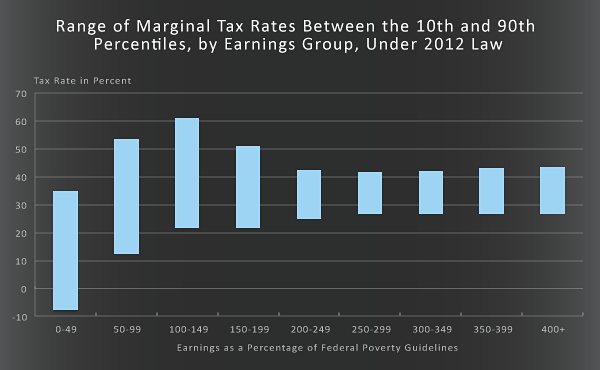Low- and Middle-Income Earners Face High Marginal Tax Rates
In a new report, the Congressional Budget Office highlights an overlooked problem: the steep marginal tax rates facing low-income Americans.
“Marginal tax rates” is a technical way of saying “disincentives to work.” In fact, some of the greatest disincentives to work have nothing to do with the tax code, but instead with government programs intended to help the poor. Those include welfare, Medicaid, housing assistance, child tax credits, and food stamps, among many others. Because these programs are means-tested, their benefits phase out as recipients’ incomes grow. For every extra dollar a recipient earns, he loses a certain amount of benefits. If the benefits phase-out is steep enough, he could lose most of or more than a dollar’s worth of benefits – that is, a marginal tax rate up to or above 100 percent.
As the CBO report makes clear, one downside of these safety net programs is that they can work against the goal of getting folks out of the safety net and back into self-sufficiency. Here is the most illustrative chart:
This chart shows that, by the CBO’s calculation, families earning a poverty-level amount of money can face marginal tax rates of up to 60 percent.
If at first that doesn’t seem remarkable, consider the current political drama over the fate of the “Bush tax cuts” for top incomes. That dispute concerns whether the top rate will go up from 35 to 39.6 percent. If families earning $250,000 a year taxed at a top rate of about 40 percent is cause for concern, clearly a 60 percent rate for a family of four making $23,050 (which would put them right at the federal poverty level) is a problem.
Another problem, of course, is that people might stop working altogether because of the incentives they face. The CBO report doesn’t include estimates of marginal tax rates facing the unemployed, because they don’t have tax return data that can be analyzed. But at such low levels of income, it’s not hard to imagine people becoming discouraged by the low returns to work.
The CBO report only considers the interaction of the tax code and a few of the largest safety net programs. It doesn’t capture the disincentives to work created by different specific federal and state programs. As the Urban Institute’s Gene Steuerle has written, “you can’t turn around today without spotting these hidden taxes in Pell grants, the AMT, and in dozens, if not hundreds, of programs.” Earlier this year, Casey Mulligan drew attention to one such example, in which a program intended to help homeowners facing foreclosure created marginal tax rates of nearly 400 percent.
Another such steep marginal tax rate to keep an eye on involves solidly middle class earners. When the Obamacare exchanges come online in the next few years, subsidies will phase out at 400 percent of the poverty level. Families at that level of income will encounter incredibly high marginal tax rates, as earning an additional dollar could result in a loss of nearly $15,000 in health insurance subsidies.




